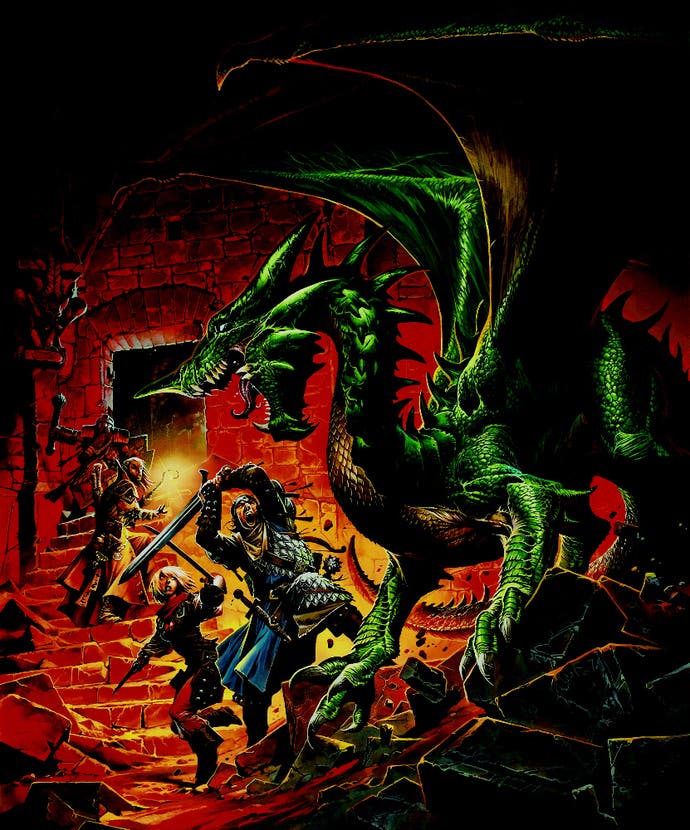Dungeons & Dragons Fourth Edition
The original pen and paper RPG. On your PC.
The last time the chaps at Eurogamer were brave enough to commission a feature about games that aren't videogames, some readers went mental. So a word of warning: if you're one of those readers, this article is about the original role-playing game, Dungeons & Dragons. Which, in case you aren't aware, isn't a videogame. But wait! Before you wander off, spitting rage all over your keyboard, come back! Because it turns out that a new subscription model and a suite of online tools take the new 4th Edition of the game closer than ever to the medium that it helped inspire. Besides, as well as just helping to spark the whole videogame medium, the Dungeons & Dragons rules form the actual bedrock of many of them (from the Gold Box series to Baldur's Gate and beyond). So even if you have a pathological distaste for non-videogame games, maybe it's still worth your while reading on to find out how the new 4th Edition rules are shaping up.
By now, even if you do have a pathological distaste for traditional gaming, you probably know the story: Dungeons & Dragons was created in 1974 by Gary Gygax and Dave Arneson, evolving out of the Chainmail wargaming rules that Gygax had co-authored a few years earlier. Inspired by a wide range of pulp fantasy and riding the tail-end of the wave of popularity that saw Tolkien embraced by the forces of flower power, it established the role-playing genre and shaped the fledgling videogame medium. Over the years it's seen two major revisions: the 2nd Edition, released in 1989; and the 3rd Edition, which was launched in 2000 (and further re-launched as version 3.5 in 2003). The latest incarnation, 4th Edition, is due to be released around the world on 6th June. And it's a pretty big deal. The initial shipment to the UK will consist of three containers, or 56 pallets in total, which adds up to just under 50 tonnes of rulebooks. If you really want to, you can do the math, but my own calculations reveal that's a lot of rulebooks.

Over the years, Dungeons & Dragons has also directly inspired several officially licensed computer games, and aside from one or two duff games (such as the terrible The Temple of Elemental Evil, for example), there have been plenty of classics. The Gold Box series kicked off in 1988 with Pool of Radiance, for example, while The Eye of the Beholder series introduced first-person adventuring a couple of years later.
There were also a couple of minor masterpieces set in the Dark Sun universe, and then in recent years BioWare and Black Isle Studios turned their attention to the licence, producing critical hits such as Baldur's Gate, Planescape: Torment, and Neverwinter Nights. There haven't yet been any official announcements about officially licensed games based on the 4th Edition rules (indeed, in the absence of any official word, it looks like Dungeons & Dragons Online will be sticking with the third edition rules). But it's almost a certainty that they will arrive in due course.
So how do the new rules shape up? We spoke to Charles Ryan, marketing manager with Esdevium Games, who will be handling the release of the game over here (and who, until recently, worked directly for the game's publisher, Wizards of the Coast, in the US). The first thing to note is that the physical products have received a makeover. The game will still be predicated on three core rulebooks, but there's a new logo, and tweaked art style, and magic items will be moving over to the Player's Handbook (instead of the Dungeon Master's Guide, where they have traditionally resided). That leaves more room in the Dungeon Master's Guide to provide more advice and tools for building adventures, although, as ever, the game will also be supported with pre-prepared adventure modules. These, though, will be graced with new serial numbers: H, standing for Heroic (saving village); P for Paragon (saving the kingdom); and E for Epic (saving the world).

Combined with a new character level cap (30, as opposed to 20 in previous versions of the game), these new demarcations reveal one aspect of the way the rules will be changing. They are an attempt to address the 'sweetspot' that has arguably existed at character levels between around 5 or 6 and 12 or 13, that made adventuring at those character levels much more fun than lower or higher levels. "The mechanics are designed to scale more consistently in 4th Edition," says Ryan. "The goal - and I think they've succeeded - is to make a game where there really isn't any difference in how much you're going to enjoy a first-level play versus a 30th-level play. They're going to feel different because they're about different things, but there's no sweetspot."







